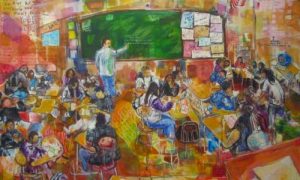PDF #13 – Androutsopoulos, Jannis Bilingualism in the mass media and on the internet
Bilingualism in mass media and internet – In Spanglish, a Hollywood movie released in late 2004, the mixed code usually referred to as Spanglish is conspicuous by its absence. The movie’s title turns out to be a metaphor for the cultural conflicts that arise when a Mexican housekeeper moves in with an Anglo family – and an eye-catcher that exploits the increased media interest in Spanglish for promotion purposes.

Current examples of the marketing of Spanish/English bilingualism in the US are not hard to fi nd. Language mixing is no doubt part of the symbolic capital that lifestyle magazines like Latina (the ‘Magazine for Hispanic Women’) and rap stars like N.O.R.E. (‘Oye Mi Canto’) sell to their audiences. Beyond the US, music with bilingual lyrics thrived in the 1990s, ranging from Algerian rai to African hip-hop, from Bollywood soundtracks to Korean pop.
While popular music audiences ‘seem more receptive to music using other languages than their counterparts of 20 years ago’ (Bentahila and Davies 2002: 190), other sorts of bilingual media messages look back to an even longer tradition, such as multilingual advertising (Piller 2003) and the use of English in the fringe media of youth subcultures, which Hess-Lüttich (1978) has termed ‘bilingualism as a style resource’. Research findings on various other sites of media discourse strengthen the impression that linguistic diversity is gaining an unprecedented visibility in the media scapes of the late twentieth and early twenty-first century.
These observations indicate a gradual shift in the sociolinguistic condition
of a domain that has traditionally been dominated by ideologies and practices
of monolingualism. Historically, the monoglot and standardized linguistic
habitus of the mass media results from their primary institutionalization as
agencies of construction of the nation-state.
After reading “Bilingualism in mass media and internet” you can check important issues for ESL teachers on the section PDFs, and visit my YouTube channel.





